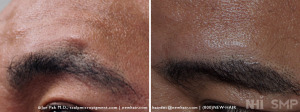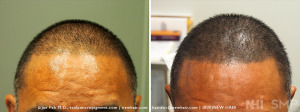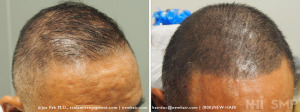Imagine, you go to buy a car, and you are clear as to what you want. A good car salesman is a professional who knows how to bond with you so that salesmen can gain their trust to possibly have you buy the next model up with loads of options without appearing too pushy. You would think that in the noble medical profession, doctors should be better than a typical car salesman. Well, the following are a few scenarios that may surprise you.
Case 1:
You are a 18 year old young man who recently noticed some frontal corner hair line thinning. Seeing your bald father, uncle, grandfather, etc. is not a confidence booster for the future of where your hair line “may” be heading and in a panic you seek the help of the nearest hair transplant surgeon. Offering a surgery to this young man (who may not follow his father’s hair loss pattern) is tantamount to malpractice yet this happens when a doctor thinks about the money he will make more than the welfare of his patient. Rapidly balding at the age of 18 is one thing, but early sign of possible hair loss from the frontal corners does not mean that this man will go completely bald. Worse yet, if you only address the front corner at a young age without a clear diagnosis and the young 18 year old loses all his hair in the coming years, the hair transplant may leave him with a freakish hairline in the front. (I have seen this happen). He won’t even be able to shave it all off if he has the linear strip scar in the back of the head. For that matter FUE still leaves whitish scars from each FUE which show when the head is completely shaven. The key here, is that this young man is desperate not to look like his bald father and uncles, and may grab onto any hair transplant solution offered to him without much long term planning. I firmly believe that patient need to know what is happening to them and they need a Master Plan in their treatment process created with his doctor.
Case 2: If you are young with early sign of male pattern balding, the doctor can offer medications (such as Propecia or Rogaine), not a hair transplant, especially if there is no clear evidence of the type of hair loss pattern and when the risk of shock hair loss is high. More doctors than I care to calculate, are quick to offer a hair transplant solution over a medical treatment that may slow down or reverse his hair loss. If medication alone buys the 18 year old even 3 to 5 years of stabilizing his hair loss and in that time a better prognosis can be made for his further hair loss pattern, it may be worth postponing a surgery, especially if the hair loss does not progress and they decide that they do not need surgery after all. If they do decide to have surgery, it would be an informed decision with plenty of background and education on the Master Plan of how to go about addressing their hair loss as they age. It is a decision based on education over scare tactics and insecurity. More over, the risk of shock loss is lower with with surgery in an older patient.
Case 3:
If you are a man over the age of 25 and you have early, but significant frontal and crown hair loss (Norwood Class 3 or 4), surgery is not out of the question. In my experience about half of these men do exactly the same as above (try the medication first and wait). Those who choose a hair transplant surgery but are told that their hair densities are low, may find that this diagnosis will limit the final hair transplant options as they bald. They might decide to transplant only the frontal area which may be a reasonable thing to do by skipping the crown area. This may be a better option for those with low donor density if they want to have a fully restored (dense) hair line. But if the surgeon offered an overly optimistic solution of covering the front and crown, the patient may run out of donor hair, unable to fully address both the front or the crown to their satisfaction as the hair loss progresses, leaving the work half finished (depleted of donor hair) before the hair transplant procedures are completed. The up-sale here means making more money (just like the car salesman) not thinking about the patient’s long term benefit.
Case 4:
You are a balding man or woman, and are offered PRP (Platlet Rich Plasma) to supplement your hair transplant. With no scientific evidence that is works, the doctor can draw a tube of blood from your arm, spin it down in a centrifuge and inject it into some part of your scalp. He charges you $1500 for this (costing him under $100) and make $1400 for this effort. Some doctors even offer this for an office visit to treat a balding man to regrow hair, but again, there is no evidence that it works.
Case 5:
You are a balding man or woman, and are offered minoxidil injections into the scalp and requested to come back every month for repeat needle injections saying that it will help grow your hair. The money is good for the doctor and may not harm you except in your pocketbook.
Case 6: You are a 29 year old women with thinning hair just like your mother and your grandmother. There is no known disease present in the hair and the doctor believes that you have genetic female hairloss. In 90% of these women with generalized thinning, a hair transplant could be called malpractice. However some doctors will recommend a hair transplant surgery. After one year when there is no significant cosmetic result their solution is to do another surgery to add more hair. Adding hair to thinning area does not always mean you will get visible (worthwhile) cosmetic results.
Case 7:
You are a man or women wanting or needing a hair transplant in a small area and most doctors would say 1500 grafts should be enough. But another doctor tells you that you need 2500 grafts to really give you the best benefit saying more is better. But at $6/graft, that is $6,000 more dollars out of your pocket into his. Did you really need that extra kick of more grafts?
Doctors have clout and their words are more persuasive than those of a salesman who have to work harder to get the up-sale. You will believe a doctor more readily than a salesman, but some of these the doctors have bills to pay, mortgages for their mansion, fancy cars to drive and at times, mistresses who need more than their sexual magnetism to be happy. These are the dollars the doctor must get from you to make a better living to meet his financial needs so up-selling may become his routine.
Case 8:
Plastic surgeons can also fall into these up-seling processes and sell many procedures to patients that they do not need. I met a 27 year old woman with hair complications (bald patches of scars) from a face lift. Now, what would drive a 27 year old women to get a face lift? Two things: (1) Body Dysmorphic Syndrome (see: HERE), and (2) an opportunistic doctor who prays on women with loss of self image.
Case 9:
A general surgeon recommend a surgery for Gall Stones that show up on an X-ray without symptoms, which do not need any surgery under ordinary situations (I am a board certified surgeon who has seen this surgery done just because there is a perceived need for the surgery by the surgeon which correlate to the paying ability of the patient or good insurance). Cardiologist who offer complex tests to young healthy patients, age 35, because they can make more money, even without clear indications other than the status of their insurance. These are just a few of the situations that reflect the up-sale scenario in the medical field. We can digress into another topic of our overly litigious society and doctors ordering excessive unnecessary tests to “cover their ass” but that is another topic and another blog post. Imagine that the risk of dying from a general anesthesia in the year following the surgery in a healthy person generally runs 1:20,000. If you are that ONE, it is 100% so this may not really be a money issue alone.
It goes without saying, that we all want a doctor who we can trust, who will tell us the truth about our medical or surgical needs without bias and secondary gain or interest. In our society doctors are placed in higher moral regards in the totem pole than used car salesman. However, this should not blind the consumer into complacency and you have a responsibility to yourself to do your research before tackling surgery.

 No difference that I know of. Regaine is the name in the UK and Australian markets. Rogaine is the name in the US market (and possibly other markets). They even share a similar logo and packaging.
No difference that I know of. Regaine is the name in the UK and Australian markets. Rogaine is the name in the US market (and possibly other markets). They even share a similar logo and packaging.


